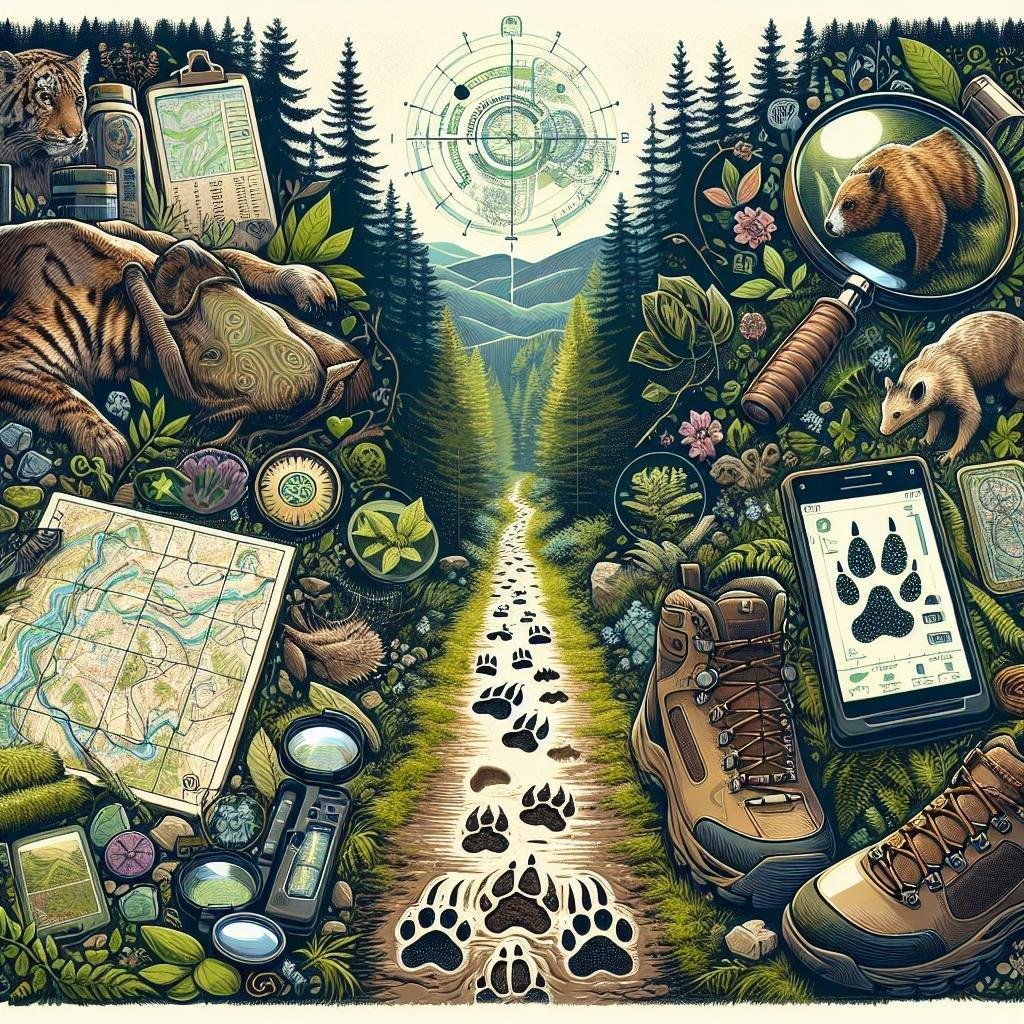Nestled in the lush expanse of the Southeastern United States, the Smoky Mountains offer a symphony of nature’s wonders, waiting to be discovered with every step along their winding trails. For the keen-eyed adventurer, the true magic often lies not in the distant vistas but in the subtle hints left behind by the park’s elusive inhabitants. As the sun filters through the dense canopy, the forest floor becomes a canvas of life, each track and sign a secret message in nature’s diary. This article invites you to become a detective of the trails, unraveling the stories written in paw prints and nibbled leaves. Whether you’re a seasoned hiker or a curious novice, learning to identify the rich tapestry of animal tracks and signs not only deepens your connection with these ancient mountains but also transforms each hike into an enriching journey of discovery. Step lightly, observe acutely, and let the Smokies reveal their hidden tales.
Spotting the Clues in the Undergrowth
As you tread lightly through the verdant corridors of the Smoky Mountains, a keen eye can unveil myriad secrets etched in the soil and greenery. The undergrowth serves as a natural tapestry where clues of resident wildlife are interwoven, waiting to be uncovered. Turning your gaze downward, seek out the subtle impressions left by creatures making their silent passage. Look for distinct footprints, such as the delicate, heart-shaped prints of deer or the wide and circular ones left by bears. Scat, too, provides hints—sometimes resembling a trail of small pellets or larger, less cohesive deposits that tell tales of diets and inhabitants. Meanwhile, the unmistakable sound of a snapping twig may guide you to the abode of a bustling creature nearby, its shelter intricately crafted among the roots or boughs.
Beyond these prints and deposits, the forest floor often bears marks of other survival tactics. Observe the trampled patches around berry-laden bushes or the nibbled edges of leaves, signs of a recent forest banquet. Inspect tree trunks for evidence of claw marks or antler rubs, where mammals such as elks or smaller woodland creatures have either sharpened their tools or marked their territory. Training your senses, you might also encounter feathers, fur, or even owls’ pellets, each clue thoughtfully placed beneath a canopy of foliage, adding rich texture to the story of the forest. To enhance your exploration, consider carrying a lightweight guidebook or downloading an app dedicated to regional flora and fauna, ensuring your treks in this vibrant ecosystem are as informed as they are exhilarating.
| Animal | Track Feature | Sign Found |
|---|---|---|
| Deer | Heart-shaped prints | Chewed twigs |
| Bear | Large circular pads | Scratch marks |
| Elk | Hoof marks | Antler rubs |

Decoding Footprints: Differentiating Between Common Species
When traversing the serene trails of the Smoky Mountains, every footprint tells a unique story. Identifying animal tracks involves recognizing subtle differences that distinguish one species from another — a true skill for any nature enthusiast. For those keen on decoding these natural scripts, it helps to start with a few common animals. Bear tracks are often identified by their large, square-like foot shape and distinct claw marks. In contrast, deer tracks display a heart-shaped arrangement, with the pointed end indicating their direction of travel. Meanwhile, raccoon footprints resemble a miniature handprint, often found near streams or water bodies. Understanding these patterns not only enriches your hiking experience but also deepens your connection with the wilderness.
Beyond tracks, the Smokies offer numerous other signs that indicate the presence of wildlife. For instance, you might spot antler rubs on trees, a sure sign of elk or deer activity. Scratch marks carved deeply into bark could reveal a bear’s dominance or mark its territory. The presence of scat, differing in size and content, provides insights into the local diet — from the omnivorous habits of the wild boar to the berry-rich diet of a black bear. Here’s a quick reference table for some common track markers:
| Animal | Track Shape | Additional Signs |
|---|---|---|
| Bear | Large, square-like with claws | Tree scratches, scat |
| Deer | Heart-shaped | Antler rubs, hoof marks |
| Raccoon | Hand-like | Food scraps near water |

Subtle Shifts: Recognizing Seasonal Track Patterns
The Smoky Mountains offer a dynamic terrain that transforms beautifully with each season, and these changes play a pivotal role in the appearance and characteristics of animal tracks. As you tread softly on hiking trails, keen observation will reveal slight modifications in the depth, clarity, and frequency of tracks, helping to unveil the unseen life of the forest. Autumn paints the ground with a mix of damp leaves and loose soil, creating a canvas where prints may appear more pronounced. In contrast, the soft, powdery snow of winter captures the impressions of padded paws and hooves with an exquisite, fleeting precision. Spring’s persistent rain showers might turn trails into a muddy tapestry, perfect for catching subtle signs of wildlife. Summer can harden the earth beneath the sun’s unforgiving glare, often making tracks less distinct but nonetheless present. Recognizing these shifts can enhance your understanding of the patterns in which animals roam and interact with their environment throughout the year.
Engaging with these cyclical track patterns also demands an awareness of changes in terrain and vegetation. Here are a few key pointers to spot seasonal track patterns during your adventures:
- Look for changes in track depth and definition according to soil moisture levels.
- Note the presence of food sources like berries or nuts that can make a path frequent, particularly noticeable in spring and autumn.
- Trail intersections often show varied prints from different species year-round. Don’t hesitate to investigate these bustling animal crossroads.
- Observe modifications in scat content, which often accompanies tracks, to deduce dietary shifts with the seasons.

Field Guide Essentials: Tools to Enhance Your Tracking Skills
Developing a keen eye for animal tracks and signs can transform your hike into an exciting wildlife detective adventure. To begin honing these skills, consider arming yourself with a few essential tools. Binoculars are vital for observing animals at a distance without disturbing them, while a magnifying glass can help you study intricate details of tracks or fur left behind. Invest in a field guide book specific to the Smoky Mountains, as it will equip you with detailed images and descriptions of local fauna and their respective signs. Photography gear, like a camera or smartphone with good zoom capabilities, will also be invaluable for documenting your findings. Lastly, consider carrying a small ruler for measuring track sizes, as this can help identify species more accurately.
Being able to distinguish between the varied traces left behind by wildlife is as much a science as an art. The following table provides a quick reference guide to some common wildlife species found in the Smoky Mountains and the tracks they leave behind:
| Species | Track | Distinct Features |
|---|---|---|
| Black Bear | Paw with five toes | Claw marks visible |
| White-tailed Deer | Heart-shaped hooves | Pointed tips |
| Raccoon | Hand-like print | Five fingers, small heel |
In addition to tracks, watch for broken branches, scat, and rubbed tree bark, as these signs often indicate animal presence. Trails rich with diverse signs can offer fascinating stories about the animals that have passed through. Engaging with these elements not only sharpens your tracking abilities but also deepens your connection to the wild landscapes around you.
Q&A
Q&A: How to Identify Animal Tracks and Signs on Hiking Trails in the Smoky Mountains
Q1: What are some common animal tracks one might encounter in the Smoky Mountains?
A1: In the Smoky Mountains, you’ll likely come across tracks from a variety of wildlife. Common tracks include those of white-tailed deer, black bears, raccoons, and wild turkeys. Each has distinct features; for example, deer tracks are heart-shaped with pointed ends, while black bear tracks are larger and show five distinct toes.
Q2: How can hiking enthusiasts differentiate between canine and feline tracks on the trail?
A2: Distinguishing between canine and feline tracks can be quite intriguing. Canine tracks, like those of wolves or coyotes, often display visible claw marks due to their non-retractable claws and have a more elongated shape. On the other hand, feline tracks, such as those from bobcats, lack claw marks because these animals retract their claws. Feline tracks also appear more rounded.
Q3: What signs, other than tracks, should hikers look for to identify the presence of wildlife?
A3: Beyond tracks, hikers can look for several signs indicating wildlife presence. Scat is a common indicator and can reveal the diet of the animal. Scratches on trees, particularly at different heights, can suggest the size and type of animal, such as bears marking territory. Additionally, feathers, fur, or nests may provide clues about bird and small mammal activity.
Q4: Are there specific times or conditions that are best for track spotting in the Smoky Mountains?
A4: The best times for spotting animal tracks are early mornings or late afternoons when the light casts shadows that highlight tracks. Post-rain conditions are ideal, as the moist ground retains imprints more clearly. Winter can also be an excellent time, as snow captures detailed impressions of the animals’ footsteps.
Q5: Can you recommend any tools or resources for helping identify animal tracks while hiking?
A5: Carrying a field guide specific to Appalachian wildlife can be immensely helpful. Apps designed for wildlife tracking can also be useful, as they often include images, descriptions, and even sound recordings. A simple smartphone camera is an invaluable tool for capturing images of tracks or signs for later identification.
Q6: What should hikers do if they encounter fresh tracks or signs of potentially dangerous animals like bears?
A6: If hikers encounter fresh signs of potentially dangerous animals, it’s important to stay calm and assess from a distance. Avoid following the tracks too closely and make noise to alert animals of your presence. Carrying bear spray is a wise precaution. In case of a bear encounter, speak loudly, back away slowly, and avoid turning your back on the animal.
Q7: Do you have any tips for beginners who are interested in learning more about wildlife tracking?
A7: Beginners should start by familiarizing themselves with the most common animal tracks in the Smoky Mountains. Joining a guided walk with a naturalist can provide firsthand learning. Practice is key, so spend time observing different tracks and signs in various conditions. Keep a journal to record observations and patterns over time, which can enhance learning and enjoyment.
This Q&A aims to equip hikers with knowledge and skills to enjoy and understand the rich wildlife landscape of the Smoky Mountains, enhancing both safety and connection to the natural world.
In Conclusion
As you lace up your boots and wander through the verdant embrace of the Smoky Mountains, each trail unfolds a silent story whispered by the forest’s inhabitants. With newfound knowledge of animal tracks and signs, your hikes transform into immersive experiences, inviting you to read the narrative etched into the earth and foliage. Whether it’s the delicate imprint of a deer’s hoof or the curious claw marks of a wandering bear, each sign is a reminder of the vibrant life that pulses through these ancient woods. As you venture forward, let your curiosity lead you, your senses sharpened and your respect deepened for the hidden wonders that lie just beneath your feet. Carry this awareness lightly, and may your journeys on these trails be rich with discovery, connection, and appreciation for the natural world that surrounds you. Safe travels, and happy tracking!

